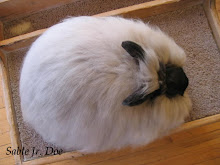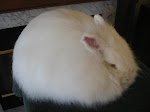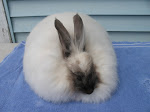About 6 months ago, a friend in my local rabbit club convinced me to switch from Heinold Wool Formula to Blue Seal Bunny 16. I was happy with Heinold on the whole and had been using it in my herd for approx. 10 years, but recently it had become difficult to get less than 6 months old, and the price (like everything else lately) had been skyrocketing:(. Since there are multiple sources for Blue Seal in this area and I was able to get it extremely fresh with a 1 week milling date, I decided to give it a try.
Over the winter while growing coats out on a few show animals, I began to notice an abnormally high incidence of woolblock in a large part of my herd. Rabbits that had not previously experienced woolblock suddenly went off feed at only 3-4 months of growth, and very young animals who were growing their first adult coats went off at only 2-3 months of growth.
After several months of this I began to suspect a problem with the feed since it was the only thing that had been changed in my barn. I noticed a change in wool and flesh condition at about the same time. Rabbits who should have been in prime coat did not have the gloss that a good French coat should have, and I began noticing that rabbits who were eating a full ration everyday were still feeling bony and thin (despite being on a regular schedule for Coccid. prevention). It had definitely been a hard, cold winter which did not encourage good condition in any case, but I had never seen quite a change over winters on the other feed, and was not willing to let things get any worse.
After looking around and talking to different people and feed stores, I found a local breeder who was going to place monthly orders of Heinold and have it stored in a very good location, so I got onto her order list and put every one of my rabbits back on the old feed.
A little while later, my dh and I butchered out some older rabbits (approx. 8-9 months old) and noticed an unbelievably high amount of fat accumulation on the outer carcasses AND surrounding all the internal organs. One of the does I put down was so bad that her organs were literally swimming in fat deposits at 8 months of age. It was absolutely everywhere:(. Michael and I agreed that we had never seen meat quality like this in all our years of raising rabbits, and I highly doubt that I would even have been able to get these does bred with such incredible fat accumulation. I had never, ever seen anything like it:(.
For anyone here who doesn't know it already, sterility in does is often caused by the accumulation of excess fat around internal/reproductive organs. This type of sterility is a problem with does who are not kept bred on a regular schedule (have been left 'fallow' for too long), and also does who have been bred later than 1-2 years of age. Something like this is a very rare condition in a young senior doe, and one that could only have been artificially produced in this situation IMO. On Heinold in the past I normally saw fat on our carcasses over the neck area and a limited amount in the body cavity, but that was the extent of this even after a long winter on a raised ration of 1 1/2 cups of pellets per rabbit. The frightening thing was that even though many of these rabbits felt bony or even underweight, they were still displaying these unheard of levels of fat that could absolutely not be felt by hand (by feeling or picking up the animal). It was a completely internal phenomenon.
After doing a LOT of thinking, I came to the conclusion that the ONLY thing that changed between my last butchering session and this recent one was a change in feed. The grain mix formulation had been altered slightly with the addition of raw wheat germ several months ago, but since each rabbit received only a Tbsp. of mix per day I could not attribute such a change to this alone. I had to conclude that the problem was the pellet itself.
It will be interesting now to see what happens the next time rabbits of a similar age are culled here. Another question that has occurred to me is whether high levels of fat could be the cause of a high incidence of woolblock. Is it possible for excess fat to put pressure on organs in such a way that the normal passage of wool is inhibited and the rabbit goes off feed as a result? I am not sure, but it does make sense and it seems possible:(. I will see if this tendency goes away at this point and keep careful track of everyone's health over the next several months.
I realize that this seems like a strange thing to post about, but since everyone uses a different type of feed and different problems crop up in herds on a regular basis, it is a good idea to post these experiences in the event that they could help someone else. Not everyone butchers their rabbits, it is true, but it is important to note that the experience of examining your stock from the inside out is a VERY useful exercise in monitoring the overall condition of your herd. Sometimes you cannot see what is going on with your rabbits just by looking at them, so the occasional necropsy is invaluable as a result. I will post more about this subject in the future and also give updates on the condition and woolblock 'rates' in my herd over the next couple of months:).
*Last minute note/disclaimer: I am not trying to criticize any particular brand of rabbit feed in this post, btw:). I do realize that many people have used Blue Seal with great success in their herds, and have never even remotely experienced the types of problems I describe here. This issue could be completely unique to my herd as so many characteristics of animals are, and I do not mean to deride Blue Seal or anyone who uses it either. I did not get this feed scientifically tested or have clinical necropsies done to formally ascertain anything. These are just my own personal observations.
More again next time and have a great (warm!!) week:-)
Sunday, March 8, 2009
Subscribe to:
Post Comments (Atom)























2 comments:
Amy, When you find time, could you (if you still have it) list the ingredients and amounts for both brands of feed. I am just learning and want to do the best for my bunnies I use Manna Pro formulas and mix wild bird seed and whole oats in with the pellets and things seem ok. I don't have any wool block problems, but my wool seems rather sparce. Maybe I can improve a bit. I don't know that either one of those brands that you mentioned are available here in Georgia. I talked to a gal last weekend and she has bunnies from your lines and she did say that a lot of quality wool is in the breeding. She and I will be working on that aspect. I am interested in LEARNING !!! She also told me that you were the best..bar none. WOW !! You have quite a fan club. :) I know her bunnies were gorgeous !!
Thanks bunches for information !!
Becca
in Georgia
I have lionhead on my backyard
Post a Comment